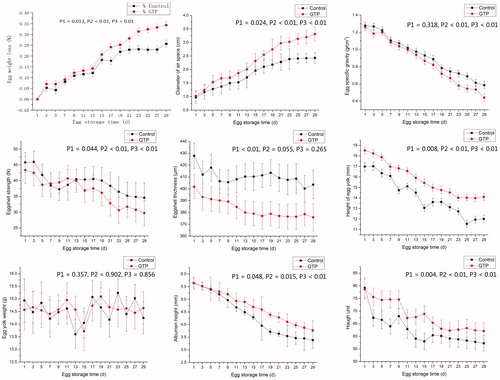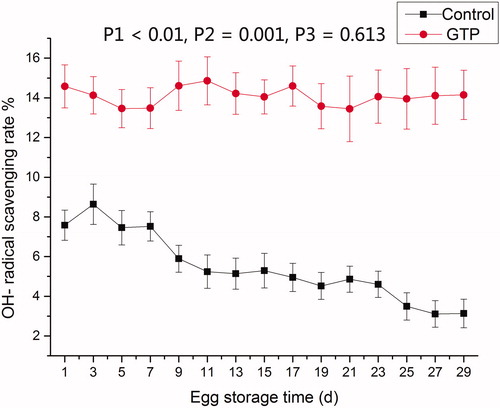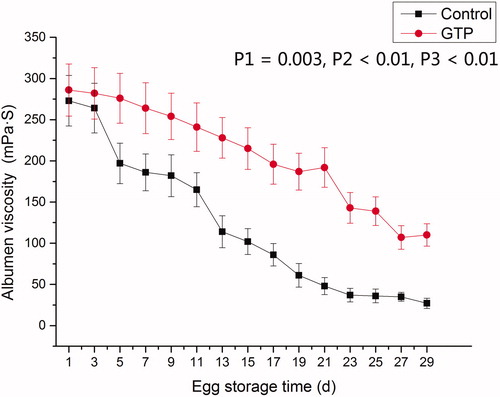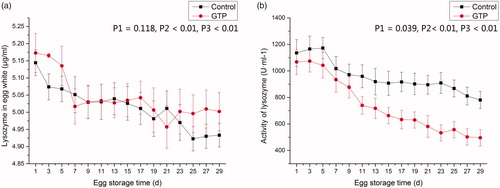Abstract
The aim of this study was to evaluate whether green tea powder (GTP) addition could affect egg quality and egg storage. Eggs were collected after 12 weeks of feeding from control and GTP treatment groups of Huainan partridge hens. Egg quality, radical scavenging capacity, albumen viscosity, lysozyme content and activity were compared between the two groups during egg storage. Eggs from hens supplemented with GTP exhibited higher albumen height, albumen antioxidant capacity, albumen viscosity and haugh unit and lower shell thickness and shell strength when compared to control group (p < .05). During egg storage, eggs from GTP group showed lower decrease of albumen height, albumen antioxidant capacity, albumen viscosity and haugh unit. Eggs from GTP group showed a greater decrease of eggshell thickness and shell strength, increased air space diameter and lower lysozyme activity as compared to the control group during egg storage (p < .05). In conclusion, GTP addition in laying hens decreased eggshell thickness and increased water evaporation from egg white, lowered the activity of lysozyme from egg white. Therefore, eggs collected from Huainan partridge hens fed GTP have poor storage stability.
Green tea powder (GTP) added in laying hens diet increased albumen height and haugh unit, and the hydroxyl radical scavenging activity of egg white.
GTP added in laying hens diet decreased eggshell thickness and shell strength.
Laying hens fed diet containing GTP increased air space diameter and lowered lysozyme activity during egg storage.
Highlights
Introduction
Egg quality is evaluated by both external and internal quality, including egg weight, eggshell strength, air space diameter, albumen height, yolk weight and albumen antioxidative activity, etc. The air space diameter is one of the most important external qualities for consumers to determine egg freshness (Wang et al. Citation2009). Chicken eggshell is a unique mineralised structure to protect the contents of egg from mechanical impact and microbial invasion (Chien et al. Citation2009). For table eggs, the eggshell functions as a packaging material and its quality is crucial for consumer selection and safety (Rodriguez-Navarro et al. Citation2002). Albumen height and haugh unit are characterised as two essential references associated with egg freshness and quality (Burley and Johnson Citation2013). Egg white is also a rich source of lysozyme, an alkaline globular protein characterised by a high enzymatic activity. During incubation, lysozyme acts as protector for the developing embryo from infection of Gram positive bacteria (Ferrari et al. Citation2006).
Egg quality is affected by many factors including breed, environmental temperature, ventilation, feed additives and so on. Therefore, hen breeders usually use plants or their extracts as feed additives to improve egg quality and achieved remarkable results (Ariana et al. Citation2011). However, the modification of physical and chemical characters of egg tends to change the storage durability of eggs (Yildirim Citation2017).
Green tea is one of the most popular beverages worldwide and produces nearly 14,380,000 tons each year in China. Nearly 5–10% green tea powder (GTP) is produced during the green tea processing and been cast off. The most common components in green tea are polyphenols, including catechins (constitute about 30% of its dry weight), alkaloid, polysaccharide, etc. Tea polyphenols are natural antioxidant that can scavenge free radicals and protect chicken magnum from damage (Wang et al. Citation2018). Laying hens fed diet with 0.5% extract of green tea showed decreased feed consumption and feed conversion ratio (Ariana et al. Citation2011). When fed quail with 2.5 g/kg catechin, the water holding capacity of breast meat was significantly increased (Kara et al. Citation2016). Xia et al. (Citation2018) suggested that diet with 1% GTP increased egg weight, albumen height and haugh unit, while more than 2% GTP supplementation decreased egg weight, eggshell thickness and strength. All mentioned researches suggest that diet containing chemical components from green tea could induce physiological reactions in hen’s body and cause physical or chemical changes in eggs. Our previous study also suggested that 1% green tea inclusion could improve meat colour and Lactobacillus proliferation for broiler production (Chen et al. Citation2019) .
It is still unknown whether diet addition of GTP in laying hens could achieve longer storage time. The aim of this study is to evaluate the effectiveness of GTP addition on egg quality and egg storage duration.
Materials and methods
All the experimental protocols involving care, handling and treatment of laying hens were approved by the Institutional Animal Care and Use Committee of Anhui Agricultural University, Hefei, Anhui, China.
Experimental design
Healthy Huainan partridge hens at 20 weeks of age with similar body weight were assigned into two groups with 460 hens in each. Hens were housed in battery cages with one hen per cage. One side of the battery cage was used as control group fed basal diet and the other side was used as the experimental group fed basal diet plus 1% GTP instead of 1% bran. The feed ingredients and its chemical composition are listed in Table . At 20 weeks of age, the diet calcium was 2.0%. With increased egg production, the calcium content also increased to 3.2% in laying hens at 32 weeks of age. The hens received 13 h light at 20 weeks to 16 h light at 32 weeks of age. After 12 weeks feeding, 110 eggs were selected from each group and 20 eggs were used for egg quality determination before storage. The remaining 90 eggs from each group were stored under ambient laboratory conditions of 25 ± 2 °C and RH 75% for 29 d. During egg storage, six eggs from each group were randomly selected every 2 d to evaluate egg quality, antioxidative capacity, albumen viscosity and lysozyme activity.
Table 1. Feed ingredients and nutrient composition.
Egg quality measurement
A digital scale (0.01 sensitivity) was used to measure the egg weight. All eggs weight was measured on the first day of storage (W0). Egg weight at each storage time was measured and marked as Wn and egg weight loss was calculated by (W0−Wn)/W0. An electronic digital calliper was used to measure the egg longitudinal diameter (LE) and transverse diameter (WE) and the egg shape was calculated by WE/LE. Egg specific gravity was determined by saline floatation method. Egg shell strength was measured by using an eggshell strength metre (2nd FI, Robotmation Co., Ltd., Tokyo, Japan). Then, the egg was broken onto a flat surface where the height of the inner thick albumen was measured with an electronic albumen height gauge (EA-01, Orka, Ramat Hasharon, Israel). The yolk height was measured by the electronic digital calliper and then was separated from the albumen and weighed. The shell thickness was measured by using a digital Vernier calliper (NFN380, Fujihira Industry Co., LTD., Tokyo, Japan). The diameter of the air space was measured by the electronic digital calliper.
Albumen antioxidative capacity
The antioxidant activity of the egg white was determined by measuring its hydroxyl radical scavenging activity (Sun et al. Citation2014).
Determination of albumen viscosity
Three eggs from each group and storage period (two replicates for each storage time point) were used in the viscosity measurement. About 30 mL of albumen from three eggs were put into a 50 mL centrifuge tube. The digital viscometer (NDJ-8s, Shanghai, China) was first adjusted to horizontal state and spindle 1–30 rpm was selected for measurement.
Lysozyme content and activity measurement
The lysozyme standard (20,000 U/mg) was diluted in 0.9% sodium chloride to different gradient concentrations (0, 0.2, 0.4, 0.8 and 1.0 mg/mL). The absorbance was measured with a microplate reader (Sunrise, Tecan Co. Ltd., Männedorf of Switzerland) at 450 nm as reference for standard curve drawing. Egg white was diluted 50 times in 0.9% sodium chloride and the pH was adjusted to 4.5 by acetic acid. After 10 min water bath at 75 °C, the solution was taken out and standing for 1 h in room condition and then subject for absorbance measurement. Lysozyme content (C) in egg white was calculated according to the standard curve.
Lysozyme activity was analysed by spectrophotometric method which is based on the measurement of absorbance changes of the solution of Micrococcus lysodeicticus bacteria during the reaction of enzyme with the bacteria cell. The procedures were according to Banerjee et al. (Citation2011) except that the absorbance was measured at 450 nm (Sunrise, Tecan Co. Ltd., Austria) at 15 and 75 s, respectively. The lysozyme activity was calculated by the equation: Lysozyme activity = (A1 − A2)/0.001 × 0.1 × C, in which A1 means the absorbance at 450 nm at 15 sand A2 means the absorbance at 450 nm at 75 s.
Statistical analysis
Egg quality between control and GTP groups were analysed by Student’s t-test. Time effect on egg quality, antioxidative capacity, albumen viscosity, lysozyme content and activity during storage was analysed by regression analysis. A significance level of p < .05 was used for all comparisons.
Results and discussion
Effect of green tea powder on egg quality
Hens fed 1% GTP did not affect egg weight, egg shape index, yolk weight and yolk colour (Table ). However, eggshell strength, egg specific gravity and eggshell thickness were significantly lowered in the GTP group as compared to the control group (p < .05, p < .05, respectively). The albumin height and Haugh unit were significantly higher in the GTP group as compared to the control group.
Table 2. Effect of green tea powder on egg quality after 12 weeks feeding.
Some plant extracts contain specific functional peptides possessing strong capability of chelating calcium (Walters et al. Citation2018). Similar study conducted by Xia et al. (Citation2018) found the inclusion of GTP might cause calcium chelation and thus decreased eggshell thickness and strength. Several studies have stated that green tea addition could increase the albumen height and HU value (Ariana et al. Citation2011; Kara et al. Citation2016). Ovomucin is one of the most important proteins that determine the albumin height. Ovomucin contains two subunits, α and β, in which the β subunit is responsible for albumin viscosity (Omana et al. Citation2010). It has been suggested that polyphenols from green tea can form complexes with proteins and polysaccharides and then increase albumin gelling (Xia et al. Citation2018). Chickens fed a diet with green tea have an increased content of β-ovomucin, thus promoting the albumin height and HU value (Xia et al. Citation2018).
Effect of green tea powder on egg quality during egg storage
During storage, egg weight loss was time-dependently decreased in both control and GTP groups (p < .01, Figure ). The egg weight loss between control and GTP group showed significant difference after 15 d of storage (p < .05). The air space diameter was time-dependently increased in both control and GTP groups (p < .01), while the increase in GTP group was greater than that of control group. The egg specific gravity was 1.2 g/cm3 at the first day of egg laying, and was about 0.5 g/cm3 after 4 weeks of storage. It was time-dependently decreased in both control and GTP groups (p < .01). The egg shell strength was also time-dependently decreased in both control and GTP groups (p < .01). The eggshell thickness and yolk weight showed no significant change during egg storage in both control and GTP groups (p>.05). The yolk height, albumin height and Haugh unit were time-dependently decreased in both control and GTP groups (p < .01), however, the decrease rate was higher in the control group than that of the GTP group.
Figure 1. Effect of green tea powder on egg quality during egg storage. P1, egg quality compared between control and GTP group. P2, regression analysis of egg quality in control group among different time points. P3, regression analysis of egg quality in GTP group among different time points. GTP: green tea powder.

Eggshell thickness is negatively related to eggshell water conductance (Brandao et al. Citation2014). The lower shell thickness observed in GTP group might cause an increased water evaporation from egg white and thus lower egg specific gravity, higher egg weight loss and air space diameter after long time storage. During egg storage, the ambient water reacted with calcium from the surface of eggshell and caused a reduced eggshell strength (Bunck et al. Citation1985).
Effect of green tea powder on egg white radical scavenging activity during egg storage
Egg white from hens fed a diet containing GTP showed a significantly increased OH− radical scavenging activity compared with those from hens in the control group (p < .01, Figure ). During egg storage, the OH− radical scavenging activity from GTP group exhibited no significant change, but time-dependently decreased in the control group (p < .01).
Figure 2. Effect of green tea powder on egg OH − radical scavenging capacity during egg storage. P1, OH − radical scavenging rate compared between control and GTP group. P2, regression analysis of OH − radical scavenging rate in control group among different time points. P3, regression analysis of OH − radical scavenging rate in GTP group among different time points. GTP: green tea powder.

Catechins in green tea can improve plasma antioxidant status through increased plasma total antioxidant activity and can decrease the peroxide level (Hashimoto et al. Citation2000; Coimbra et al. Citation2006). Pietta and Simonetti (Citation1998) suggested that catechins and their metabolites might exert their antioxidant protection in vivo through inhibiting reactive oxygen species (ROS) generation and down regulation of activated polyADP-ribose polymerase and caspase-3. As small molecules, catechin and tea polyphenols can easily transfer from the blood to organs including the ovary and magnum, which resulted in an increased antioxidant capacity in egg white from chickens fed a diet with GTP. With the protection from eggshell membrane, the catechins and their metabolites might be well kept in the albumin during storage as a result they have a relatively higher OH− radical scavenging rate. The peptides derived from egg white has been demonstrated exhibiting antioxidant activity in vitro (Fatah et al. Citation2018). During egg storage, the main component of ovodefensin rapidly degraded and disappeared at 28 d of storage (Liu et al. Citation2018). The degradation of these innate peptides during storage contributes to a decreased antioxidant capacity of egg white. The degradation of ovodefensin, ovotransferrin and ovomucin during storage contributes to egg white thinning (Liu et al. Citation2018). Polyphenols from green tea increased albumin gelling (Xia et al. Citation2018) which might also slow down the thinning process of egg white observed in eggs from GTP group during storage.
Effect of green tea powder on egg white viscosity during egg storage
The albumen viscosity from GTP group was significantly higher than that of eggs from the control group (p < .01, Figure ). The albumen viscosity showed a time-dependent decrease in both GTP and control groups (p < .01, p < .01, respectively). However, the albumen viscosity decrease in control group was more than that of the GTP group. The higher viscosity from GTP group might due to its higher haugh unit and albumen height. The increased water evaporation from eggs of GTP group also kept higher albumen viscosity.
Figure 3. Effect of green tea powder on albumen viscosity during egg storage. Note: P1, albumen viscosity compared between control and GTP group. P2, regression analysis of albumen viscosity in control group among different time points. P3, regression analysis of albumen viscosity in GTP group among different time points. GTP: green tea powder.

Effect of green tea powder on the content and activity of albumen lysozyme during egg storage
The content of lysozyme showed no significant difference between GTP and control group (p>.05, Figure ). The content of lysozyme was time-dependently decreased in both GTP and control group (p < .01). Feeding with GTP lowered the enzymatic activity of egg white lysozyme as compared to that of the control group (p < .05, Figure ). During egg storage, the activity of lysozyme from control group was slightly decreased (p < .01). While in GTP group, egg white lysozyme was significantly decreased from 1067 U/mg at the first day to 739 U/mg after 11 d of storage. Study conducted by Wang et al. (Citation2017) suggested that some growth stimulators used in laying hens had a positive effect on egg laying and egg weight. However, researches suggested that feeding modifications such as rapseed meal, fish-mineral, humocarbovite or antioxidative substances lowered the enzymatic activity of egg white lysozyme although the observed differences were not higher than ten percent (Kopeć et al. Citation2005).
Figure 4. Effect of green tea powder on albumen lysozyme and lysozyme activity during egg storage. (a) lysozyme content in egg white, and b, lysozyme activity in egg white. P1, lysozyme content (a) or activity (b) compared between control and GTP group. P2, regression analysis of lysozyme content (a) or activity (b) in control group among different time points. P3, regression analysis of lysozyme content (a) or activity (b) in GTP group among different time points. GTP: green tea powder.

Conclusions
Eggs from Huainan partridge hens supplemented with GTP decreased eggshell thickness and strength and thus caused an increased water evaporation from egg white. GTP addition lowered the activity of lysozyme from egg white. However, GTP addition increased the antioxidant capacity, albumin viscosity and Haugh unit during storage.
Ethical approval
All the experimental protocols involving care, handling, and treatment of broilers were approved by the Institutional Animal Care and Use Committee of Anhui Agricultural University, Hefei, Anhui, China. The permission number is No. SYDW-P2018110702.
Acknowledgements
The authors thank Dr. Jinbao Huang from the State Key Laboratory of Tea Plant Biology and Utilisation, Anhui Agricultural University, for providing the chemical composition of dried green tea powder. The authors thank Grace F. Boni from Southwest University for helping us edited the grammar.
Disclosure statement
The authors declare that there is no conflict of interest regarding the publication of this article.
Additional information
Funding
References
- Ariana M, Samie A, Edriss MA, Jahanian R. 2011. Effects of powder and extract form of green tea and marigold, and α-tocopheryl acetate on performance, egg quality and egg yolk cholesterol levels of laying hens in late phase of production. J Med Plants Res. 5:2710–2716.
- Banerjee P, Keener KM, Lukito VD. 2011. Influence of carbon dioxide on the activity of chicken egg white lysozyme. Poult Sci. 90(4):889–895.
- Brandao MDM, Santos FF, Machado LS, Verinaud MS, Oliveira JM, Soares NM, Nascimento ER, Pereira V. 2014. The effect of eggshell apex abnormalities on table egg quality during storage in 2 seasons of the year. Poult Sci. 93(10):2657–2662.
- Bunck CM, Span JW, Pattee OH, Fleming WJ. 1985. Changes in eggshell thickness during incubation: implications for evaluating the impact of organochlorine contaminants on productivity. Bull Environ Contam Toxicol. 35(2):173–182.
- Burley HK, Johnson CL. 2013. Market survey of quality and freshness of eggs produced under an enhanced hen nutrition and egg production program. J Appl Poult Res. 22(4):929–933.
- Chen X, Zhu W, Liu X, Li T, Geng Z, Wan X. 2019. The growth performance, meat quality, and gut bacteria of broilers raised with or without antibiotics and green tea powder. J Appl Poult Res. 28(3):712–721.
- Chien YC, Hincke MT, McKee MD. 2009. Ultrastructure of avian eggshell during resorption following egg fertilization. J Struct Biol. 168(3):527–538.
- Coimbra S, Santos-Silva A, Rocha-Pereira P, Rocha S, Castro E. 2006. Green tea consumption improves plasma lipid profiles in adults. Nutr Res. 26(11):604–607.
- Fatah A, Meihu M, Ning Q, Setiani BE, Bintoro VP. 2018. Chemical structure, comparison antioxidant capacity and separation antioxidant of hen, duck and quail egg white protein hydrolysate. IOP Conf Ser Earth Environ Sci. 102:012099.
- Ferrari RP, Martinelli R, Saino N. 2006. Differential effects of egg albumen content on barn swallow nestlings in relation to hatch order. J Evol Biol. 19(3):981–993.
- Hashimoto R, Yaita M, Tanaka K, Hara Y, Kojo S. 2000. Inhibition of radical reaction of apolipoprotein B-100 and alpha-tocopherol in human plasma by green tea catechins. J Agric Food Chem. 48(12):6380–6383.
- Kara K, Şentürk M, Guclu BK, Sariözkan S, Eren M. 2016. Effect of catechins on fattening performance, meat quality, some antioxidant and blood parameters and fattening costs in Japanese quail (Coturnix coturnix japonica). Br Poult Sci. 57(4):522–530.
- Kopeć W, Skiba T, Korzeniowska M, Bobak L, Trziszka T. 2005. Activity of protease inhibitors and lysozyme of hen’s egg white depending on feed modification and egg storage. Pol J Food Nutr Sci. 14(55):79–83.
- Liu M, Yu W, Ren F, Wu J. 2018. Formation and characterization of peptides in egg white during storage at ambient temperature. Food Chem. 263:135–141.
- Omana DA, Wang JP, Wu JP. 2010. Ovomucin - a glycoprotein with promising potential. Trends Food Sci Technol. 21(9):455–463.
- Pietta P, Simonetti P. 1998. Biochemistry and molecular biology international: dietary flavonoids and interaction with endogenous antioxidant. Australia: Academic Press.
- Rodriguez-Navarro A, Kalin O, Nys Y, Garcia-Ruiz JM. 2002. Influence of the microstructure on the shell strength of eggs laid by hens of different ages. Br Poult Sci. 43(3):395–403.
- Sun S, Niu H, Yang T, Lin Q, Luo F, Ma M. 2014. Antioxidant and anti-fatigue activities of egg white peptides prepared by pepsin digestion. J Sci Food Agric. 94(15):3195–3200.
- Walters ME, Esfandi R, Tsopmo A. 2018. Potential of food hydrolyzed proteins and peptides to chelate iron or calcium and enhance their absorption. Foods. 7(10):172.
- Wang H, Zhang HJ, Wang XC, Wu SG, Wang J, Xu L, Qi GH. 2017. Dietary choline and phospholipid supplementation enhanced docosahexaenoic acid enrichment in egg yolk of laying hens fed a 2% schizochytrium powder-added diet. Poult Sci. 96(8):2786–2794.
- Wang Q, Deng X, Ren Y, Ding Y, Xiong L, Wen Y, Wang kS. 2009. Egg freshness detection based on digital image technology. Sci Res Essays. 4:1073–1079.
- Wang X, Wang X, Wang J, Wang H, Zhang H, Wu S, Qi G. 2018. Dietary tea polyphenol supplementation improved egg production performance, albumen quality, and magnum morphology of Hy-line brown hens during the late laying period. J Anim Sci. 96(1):225–235.
- Xia B, Liu Y, Sun D, Liu J, Zhu Y, Lu L. 2018. Effects of green tea powder supplementation on egg production and egg quality in laying hens. J Appl Anim Res. 46(1):927–931.
- Yildirim A. 2017. Changes in quality characteristics during storage time of eggs from layer hens fed diet supplemented with Panaxginseng Meyer leaf extract. Prog Nutr. 19:197–204.
